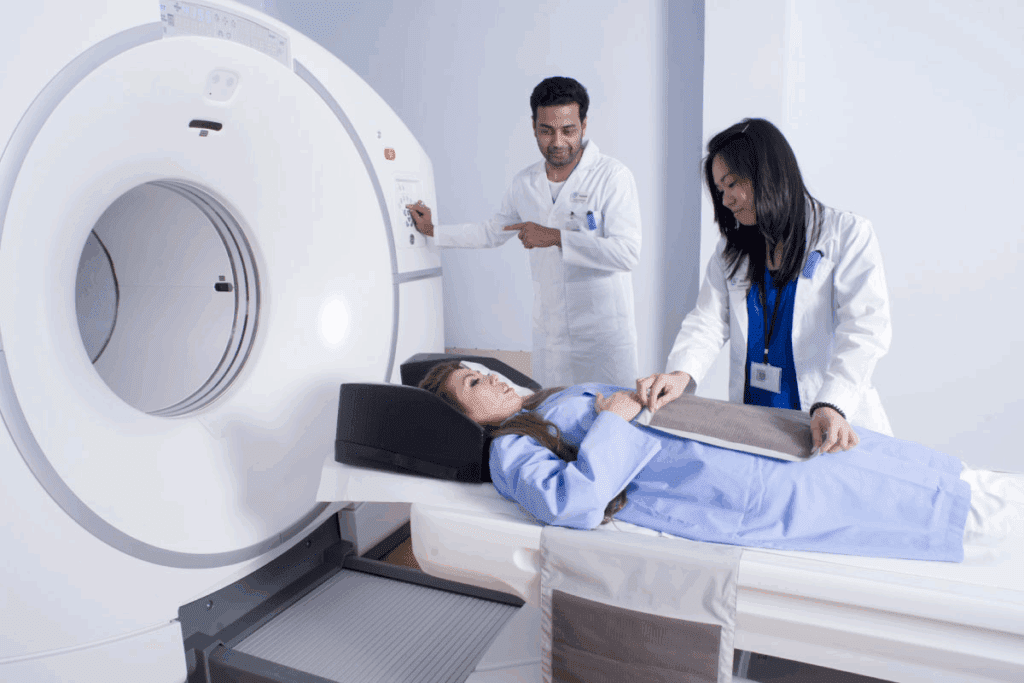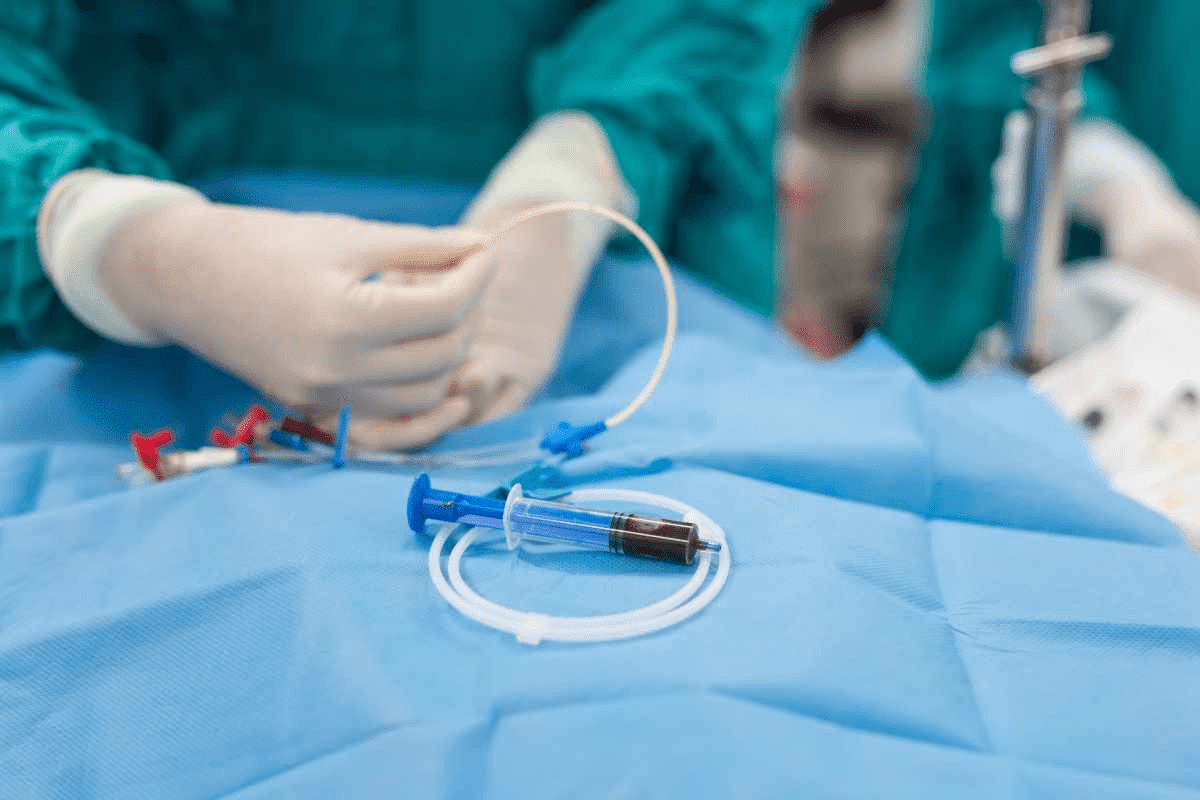Last Updated on November 26, 2025 by Bilal Hasdemir

Medical students looking into interventional radiology have a special chance to join an integrated residency program. Choosing a residency program is a big decision. We aim to provide top-notch medical education and training. What is an integrated interventional radiology residency? Get 5 key facts about this modern training pathway, its length, and its benefits.
At Liv Hospital, we focus on patient care to train the next IR leaders. Our integrated IR residency programs are five-year tracks. They start with a clinical internship year. This prepares residents in both diagnostic and interventional skills.
These programs are perfect for students sure they want to be IR specialists. They mix diagnostic radiology with interventional skills. This gives a full training path.
Key Takeaways
- Integrated IR residency programs are five-year tracks.
- Programs include a clinical internship year.
- Training covers both diagnostic and interventional radiology.
- Ideal for medical students certain about their IR career path.
- Comprehensive pathway combining diagnostic and interventional skills.
The Evolution of Interventional Radiology as a Medical Specialty

Interventional radiology has grown fast and made a big impact. It has become a key part of today’s healthcare.
Historical Development of IR Procedures
IR started in the early 1900s with radiologists using fluoroscopy for procedures. It has grown with new tech like catheters and MRI.
IR’s history includes big steps:
- Angiography in the 1960s for better blood vessel views.
- New catheter tech for more complex treatments.
- Embolization for bleeding and tumor treatment.
- Stent tech for vascular disease.
Now, IR is a key field with less invasive options than surgery.
Recognition as a Primary Specialty
IR became a main specialty in 2012. The American Board of Medical Specialties (ABMS) made it official. This led to the Integrated Interventional Radiology Residency programs.
Today, IR programs mix three years of radiology with two of IR. This way, residents get trained in both areas. They can get certified in both.
There are over 2,000 SIR trainee members worldwide. They’re exploring or in these programs. This shows IR’s growing role in healthcare.
IR’s growth means better care for patients. It offers more treatment choices and pushes for new, less invasive methods.
What Is an Integrated Interventional Radiology Residency?

Integrated Interventional Radiology Residency programs are changing radiology. They mix training in both diagnostic and interventional radiology. This makes IR residents well-rounded professionals.
Definition and Program Structure
An Integrated Interventional Radiology Residency is a detailed training program. It combines diagnostic radiology with interventional skills. The program lasts six years, with the first three years on diagnostic radiology.
Residents learn in many areas, like body CT and MR, and more. This broad learning helps them understand imaging and techniques well. The program builds skills from simple to complex, preparing residents for today’s radiology.
Difference Between IR/DR and Traditional Diagnostic Radiology
IR/DR programs differ from traditional diagnostic radiology. IR/DR programs include both interventional and diagnostic training. Traditional programs focus mainly on diagnostic imaging.
IR/DR programs teach residents to do procedures and manage patients. They also learn to interpret images. This training opens up more career paths, from research to private practice.
Knowing about Integrated Interventional Radiology Residency programs helps medical students choose their path. They can pick a program that fits their goals and interests.
How Long Is Interventional Radiology Residency?
Knowing how long an interventional radiology residency lasts is key for those aiming to be IR specialists. These programs are set up to give residents the right amount of clinical and technical training. This is essential for a successful career in IR.
We will look into the structure of these programs. They usually last several years. This gives a solid base in both diagnostic radiology and interventional procedures.
The Six-Year Training Pathway
The interventional radiology residency is a six-year program. It starts with a clinical year. Then, it has five years of specialized training in IR.
The six-year plan balances clinical practice, diagnostic imaging, and interventional procedures. This makes sure residents are ready for the challenges of IR today.
Interventional Radiology Residency Length Breakdown
The IR residency is divided into parts. The first year is a clinical internship. It lays a broad foundation in patient care. The next years focus on training in diagnostic radiology and IR.
Here’s a simple breakdown:
- Year 1: Clinical internship
- Years 2-3: Diagnostic radiology training
- Years 4-6: Advanced IR training
Over these six years, residents see many cases. This improves their skills in diagnosis and procedures. The program meets ACGME standards, preparing graduates for board certification.
With five residents starting each year, the learning experience is thorough. The curriculum and hands-on training help residents become skilled IR professionals.
Key Fact #1: Dual Board Certification Opportunity
The IR/DR residency pathway offers a chance for dual board certification. This is a big plus for those aiming to be interventional radiologists. It lets them get certified in both Diagnostic Radiology (DR) and Interventional Radiology (IR), broadening their career paths.
Qualification Process for Both DR and IR Boards
To get dual certification, residents must finish the IR/DR residency program. This program covers both diagnostic and interventional radiology. It prepares them for various procedures, including vascular interventions, for both DR and IR exams.
Key components of the qualification process include:
- Completing the six-year integrated IR/DR residency program
- Meeting the clinical and procedural requirements for both DR and IR specialties
- Passing the board examinations for both Diagnostic Radiology and Interventional Radiology
Career Advantages of Dual Certification
Dual certification in DR and IR boosts a radiologist’s career. It shows they are skilled and versatile, making them stand out. This certification also opens more doors for practice, from imaging to complex procedures.
The benefits of dual certification include:
- Increased job opportunities in both academic and private practice settings
- Enhanced credibility and professional reputation
- Greater flexibility in career choices, including leadership roles
Dual certification lets interventional radiologists reach their full career goals. They can also help patients more effectively.
Key Fact #2: Comprehensive Diagnostic Radiology Foundation
The first three years of an Integrated Interventional Radiology residency program focus on building a strong diagnostic radiology foundation. This training is key for preparing residents for advanced procedures and techniques later on.
Three Years of Diagnostic Imaging Training
Residents spend the first three years rotating through different diagnostic imaging areas. This broad training helps them understand radiologic principles and practices. It prepares them to interpret imaging studies and make informed patient care decisions.
Residents learn about various imaging modalities and techniques. This includes body CT, fluoroscopy, MRI, and more. They also study breast imaging, chest radiology, and other areas.
Essential Imaging Modalities Covered
The curriculum ensures residents become proficient in interpreting images from different modalities. The table below shows the key imaging modalities and areas of focus during training:
| Imaging Modality | Areas of Focus |
| Body CT | Abdominal and pelvic imaging |
| Fluoroscopy | Gastrointestinal and genitourinary studies |
| MRI | Musculoskeletal, neurological, and body imaging |
| Breast Imaging | Mammography and breast ultrasound |
| Ultrasound | Abdominal, obstetric, and vascular ultrasound |
A leading radiologist notes, “A strong foundation in diagnostic radiology is essential for future interventional radiologists. It helps them understand imaging complexities and make informed decisions during procedures.”
“Understanding the nuances of diagnostic imaging is fundamental to the practice of interventional radiology.”
Integrated Interventional Radiology residency programs give residents a solid diagnostic radiology foundation. This prepares them for advanced training in interventional techniques and procedures.
Key Fact #3: Advanced Procedural Training in IR Residency Programs
IR residency programs focus on advanced procedural training. They make sure residents can handle many interventional radiology techniques. This training is key to getting IR residents ready for the challenges of real-world practice.
Types of Procedures IR Residents Perform
In their 4th and 5th years, IR residents learn IR procedures. They get hands-on with many techniques. This includes vascular procedures like angioplasty and stenting, and non-vascular ones like biopsies and drainages.
This variety helps IR residents become skilled in many areas. They can tackle different clinical situations with ease.
Progressive Technical Skill Development
IR residency programs build progressive technical skill development. Residents start with basic skills and move to more complex ones. This keeps them constantly improving their skills.
This method is vital for IR residents. It lets them confidently do advanced procedures and keep up with new technologies.
Key Fact #4: Clinical Management Experience for IR Residents
Clinical management is key for IR residents. It’s not just about technical skills. It’s about understanding how to manage patients well. IR programs give residents lots of experience in clinics and during hospital visits.
Outpatient Clinic Responsibilities
IR residents work in outpatient clinics. They check patients, plan treatments, and follow up with them. They learn how to manage patients over time.
They also learn to talk to patients clearly. They discuss treatment options and what to expect. This helps them develop important communication skills.
Inpatient Consultation Services
IR residents also work in hospitals. They help other teams with IR consultations. They decide if IR procedures are needed and help with complex patient care.
This experience helps them see how IR fits with other specialties. They learn to make quick decisions in busy situations. This prepares them for real-world practice.
IR programs mix clinic work with hospital visits. This gives residents a broad education. They’re ready to care for patients well after their training.
Key Fact #5: Research and Academic Opportunities in Integrated IR Residency
Research and academic chances are key in integrated interventional radiology (IR) residency programs. They boost IR residents’ skills and help grow the field.
Scholarly Project Requirements
IR residency programs ask residents to do scholarly projects. These can be research studies, case reports, or systematic reviews. They help improve critical thinking, research skills, and writing.
Key parts of scholarly projects include:
- Identifying a research question or hypothesis
- Conducting a literature review
- Designing and implementing the research methodology
- Analyzing data and drawing conclusions
- Presenting findings in a written report or presentation
Conference Presentations and Publications
IR residents are urged to share their research at big conferences. For example, the Society of Interventional Radiology (SIR) annual meeting. This helps them get better at explaining complex ideas to experts.
Getting published in respected journals is also key. Residents should aim to publish their work in top journals. This boosts their academic record and adds to the field’s knowledge.
Through research and academic work, IR residents build a strong base. They learn about evidence-based practice, critical thinking, and sharing knowledge. These skills are vital for a career in interventional radiology.
What Makes Top Interventional Radiology Programs Stand Out
The best interventional radiology residency programs are known for their strong mentorship, advanced training, and teamwork. They offer a deep education that prepares residents for today’s interventional radiology challenges.
Mentorship Quality and Accessibility
Top interventional radiology programs are known for their mentorship. With 60+ faculty members, they provide personalized guidance. This support helps residents overcome education and career hurdles.
Advanced and Innovative Procedural Exposure
These programs give residents a chance to learn new and complex procedures. They are trained in many procedures, from vascular to non-vascular. This broad training prepares them for the latest in the field.
| Procedural Category | Examples of Procedures | Training Focus |
| Vascular Interventions | Angioplasty, Stenting, Embolization | Technical proficiency, Patient selection |
| Non-Vascular Procedures | Biopsies, Drainage, Tumor Ablation | Image guidance, Complication management |
| Emerging Techniques | IR-guided pain management, Advanced embolization techniques | Innovation, Research integration |
Multidisciplinary Collaboration Opportunities
Multidisciplinary teamwork is key in top IR programs. Residents work with other specialties, improving patient care and learning. This teamwork broadens their understanding and skills.
These programs combine mentorship, advanced training, and teamwork. This approach ensures residents are ready to succeed in their careers and advance the field of interventional radiology.
The Competitive Application Process for IR/DR Residency Programs
Starting your journey to become an interventional radiologist means facing a tough application process. It’s key to know the competitive field and what it takes to stand out.
Application Timeline and Requirements
The application for IR/DR residency programs starts in June with the ERAS (Electronic Residency Application Service) timeline. You’ll need to apply through ERAS, including your transcripts and letters of recommendation. Remember, each program might ask for different things, like a personal statement or research abstracts.
To keep up, make a detailed plan. This should include:
- Looking into programs and making a list of IR/DR residencies you’re interested in
- Getting your ERAS application ready and submitted
- Asking for letters of recommendation
- Signing up for and taking the USMLE (United States Medical Licensing Examination) or COMLEX (Comprehensive Osteopathic Medical Licensing Examination)
Factors That Make Candidates Competitive
So, what makes a candidate stand out for IR/DR residency programs? Several things are important:
- Academic excellence: A good academic record, with high grades and USMLE scores, is key.
- Research experience: Being involved in research, preferably in interventional radiology, shows your dedication.
- Clinical experience: Having experience in radiology, like internships or rotations, is valuable.
- Leadership and extracurricular activities: Showing leadership and participating in other activities highlights your well-roundedness.
Knowing the application timeline, what’s needed, and what makes a strong candidate helps. This way, aspiring interventional radiologists can get ready for the journey ahead.
Career Paths After Completing an Integrated IR Residency
Finishing an integrated IR residency opens many doors. You can work in academic or private settings. You’ll have skills in radiology, interventional procedures, and patient care.
Academic vs. Private Practice Opportunities
IR residents can pick between academic and private practice. Academic jobs involve research, teaching, and improving IR techniques. Private practice might offer more money and less paperwork, focusing on patient care.
Here’s a table comparing these paths:
| Career Aspect | Academic Career | Private Practice |
| Primary Focus | Research, Education, IR Advancements | Patient Care, Procedural Work |
| Work Environment | Universities, Teaching Hospitals | Private Hospitals, Clinics |
| Opportunities for Advancement | Publishing Research, Leading Departments | Growing Practice, Specializing |
Subspecialization Through Fellowship
Many choose to specialize further through fellowships. These programs offer advanced training in areas like neurointervention or oncology. Fellowships boost your skills and open up new career paths.
Emerging Practice Areas in Interventional Radiology
IR is always changing, with new areas like IR oncology and women’s health. These new fields expand IR’s scope and offer fresh career paths.
Keeping up with IR’s growth can give you an edge. Whether in academia, private practice, or fellowships, IR offers diverse and promising careers.
Conclusion: The Future of Integrated Interventional Radiology Training
Looking ahead, integrated interventional radiology training programs will keep growing. They will adapt to the fast-changing world of healthcare. New techniques and technologies will help improve patient care.
Top IR residency programs around the world will focus on mentorship and advanced training. They will also introduce new techniques. This way, the next IR professionals will be ready for the challenges of their field.
The future of IR training will be shaped by new technologies and the need for skilled IR specialists. As programs evolve, we’ll see better training in integrated interventional radiology. This will help patients and healthcare systems everywhere.
FAQ
What is an integrated interventional radiology residency?
An integrated interventional radiology residency is a six-year program. It combines training in diagnostic radiology with interventional skills. This path leads to dual board certification in both areas.
How long is an interventional radiology residency?
An interventional radiology residency lasts six years. It offers a full training in both diagnostic and interventional radiology.
What are the benefits of dual board certification in IR and DR?
Getting dual board certification in IR and DR boosts your credibility. It opens more career doors. It also gives you a solid base in both areas.
What kind of training can I expect in an IR residency program?
IR residency programs offer deep training in diagnostic radiology. They also focus on advanced interventional procedures. You’ll get experience in clinical management, research, and academics.
What makes top interventional radiology programs stand out?
Top programs are known for their mentorship and procedural training. They also offer chances to work with different teams. This creates a supportive and engaging learning space.
How competitive is the application process for IR/DR residency programs?
Applying to IR/DR programs is very competitive. You need a strong application. This includes a good personal statement, top grades, and research experience.
What career paths are available after completing an integrated IR residency?
After finishing an IR residency, you can work in academia or private practice. You can also specialize through fellowships. Or, you can explore new areas in interventional radiology.
What is the difference between IR/DR and traditional diagnostic radiology programs?
IR/DR programs teach both diagnostic radiology and interventional skills. Traditional programs mainly focus on diagnostic imaging.
Are research and academic opportunities available in IR residency programs?
Yes, IR residency programs include research and academic chances. You’ll work on scholarly projects, present at conferences, and publish papers. This helps you think critically and boosts your professional standing.
Reference
- U.S. National Library of Medicine. (2024). Interventional radiology residency. MedlinePlus. https://medlineplus.gov/ency/article/007535.htm






